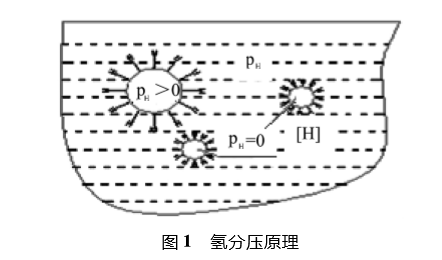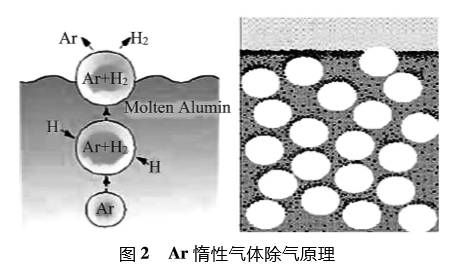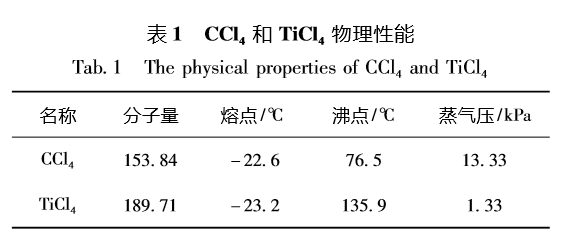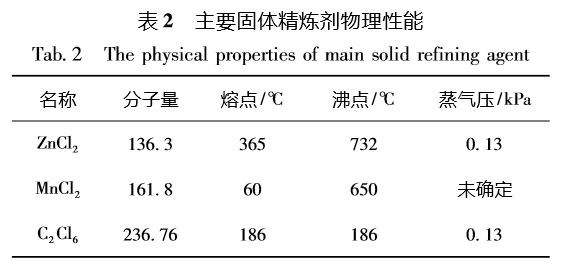Double-zero aluminum foil is non-toxic, odorless, shading, moisture-proof, corrosion-resistant, light-weight, high-barrier, anti-ultraviolet, easy to flex when used in deep processing, excellent adhesion and heat-sealability, and excellent surface printing performance. Widely used in cigarettes, medicine, food, electronics, household chemicals and other industries. During use, the double-zero aluminum foil thickness reaches double zero five and double zero, and even thinner, so the mechanical properties and pinhole degree of the double zero aluminum foil have higher requirements. However, in the melting process of molten aluminum, due to the presence of impurities such as hydrogen and aluminum oxide, double-zero aluminum foil often fails to meet the required performance, and even produces waste products, which seriously affects the economic efficiency of the company. How to improve the quality of liquid aluminum solution, effective removal of impurities such as hydrogen and alumina, the key link is the refining process.  The methods for refining aluminum liquids can be divided into two major categories: one is the adsorption method, and the other is the contact between the adsorbent and the melt, so that the impurities of the adsorbent and the melt can be physically, chemically, physically, or mechanically affected, thereby achieving the elimination of hydrogen. The purpose of impurity removal; the second is the non-adsorption method, which changes the equilibrium state of metal and gas and inclusion systems through physical effects such as vacuum, ultrasonic waves, and density difference, thereby separating gases and impurities from the aluminum liquid. Although the vacuum processing method has its own Advantages, but the equipment is expensive and costly, and it has not been widely used. In the actual production process, non-adsorption method is rarely used, and its main emphasis is on laboratory theoretical research. In recent years, ultrasonic treatment and electromagnetic purification technology have become hot spots for the study of melt purification. In the smelting process, the most widely used method is the adsorption method, and the adsorption method includes the medium filter method and the floating method. Because floatation is easier to operate and does not cause secondary hazards, it is the most widely used refining technology. In this paper, the production experience of the production of double zero aluminum foil casting blanks is combined with other literatures, and the floatation method is introduced in detail in the application of casting and rolling smelting.  First, the floatation method of classification and floating principle The principle of floating refining is to use gas partial pressure to form a large number of bubbles with a hydrogen partial pressure of 0 in the solution (see Fig. 1), forming a driving force for hydrogen to continuously diffuse into the bubbles until the hydrogen partial pressure satisfies the relation of formula 1 in order to achieve balance.  [H] bubble = [H] solution = kPH2 (1)  The bubbles in the liquid will float up and out of the surface to achieve the purpose of removing hydrogen. Oxide inclusions and hydrogen can be chemically adsorbed together. Therefore, in the process of escaping the liquid surface, the bubbles adsorb and erode inclusions on the one hand, and on the other hand, remove hydrogen that has been adsorbed on the inclusions.  Depending on the type of refining agent used, the floating refining method can be divided into four types: gas refining, liquid refining, solid refining and metamorphic refining. Second, refining process 2.1 Gas refining The gas refining agent mainly includes three types of inert gas (N2 or Ar), reactive gas (Cl2) and mixed gas (N2, Cl2 or N2, Cl2, CO).  (1) Inert gases often use non-toxic and non-corrosive N2 or Ar, and are relatively cheap. The degassing tube is used to pass N2 or Ar into the aluminum solution. Since the initial partial pressure of hydrogen in N2 or Ar is 0, the hydrogen in the aluminum solution will continuously enter the bubbles formed by N2 or Ar and then follow the bubble from the solution. In the middle discharge, oxygen inclusions will be adsorbed in the process of bubbles escaping from the solution, so as to achieve the effect of degassing and impurity removal (see Figure 2). In the refining process of double zero foil cast billet aluminum liquid, since N2 can not effectively remove slag such as Ca, Na, etc., Ar refining is used during refining, the refining time is generally 8 to 12 minutes, and the refining temperature is 725 to 735°C. Blowing pressure is controlled between 0.1 and 0.3 MPa. As the bubbles are finer and the distribution is more uniform, the distance of hydrogen in the aluminum solution into the bubbles is short, and the time for the bubbles to escape the liquid surface is long, so that a better degassing effect can be achieved. Therefore, porous graphite or refractory material is generally used as a vent plug to make refining more fully. (2) Cl2 is generally used as the reactive gas, and ClCl2 reacts with the aluminum solution to generate AlCl3 (such as formulas 2, 3, and 4). When the temperature is 700°C, the vapor pressure of AlCl3 is 2.2 × 106 MPa, so bubbles will form floating. On the reaction exothermic, hydrogen and oxygen inclusions will be removed as the bubbles float together. The Cl2 refining temperature is generally 690-710°C, the time is generally 10-15 minutes, and the inlet pressure is 1.5-2.5×104 MPa. When using Cl2 refining, a pre-drying process is required to prevent the generation of water vapor in the solution. The long-term production practice proves that the refining effect of Cl2 is good, but its toxicity is great, it is harmful to human health, and it pollutes the environment and corrodes the production equipment, so it is generally not used. (3) The mixed gas can absorb the advantage of the individual gas to a certain extent, and the refining effect will be better, but the process is relatively complicated and the process temperature is more difficult to control.  2.2 Liquid refining Liquid refining mainly uses two refining agents, CCl4 and TiCl4 (see Table 1 for their physical properties). CCl4 is a transparent and volatile liquid, which is colorless, special odor, toxic gas, and has strong irritation to skin, eyes and mucous membranes. Inhalation may be fatal due to inflammation, edema, etc. Adding aluminum solution, at high temperatures, CCl4 decomposes to produce C2Cl4 and Cl2. The boiling point of C2Cl4 is 121 °C, which will form a bubble-like rise. Together with Cl2, it plays a refining role in the ascending process. During the refining process, the CCl 4 addition temperature is 720-740° C., and the amount added is 0.2%-0.4% of the total mass of the aluminum liquid. At the same time, CCl4 reacts with aluminum matrix to produce Al4C3, which can change the nature of the solidification process and refine grains. At room temperature, TiCl4 is a colorless, odorless, transparent liquid that chemically reacts in aluminum solution to form AlCl3 and Ti (reaction formula is shown in 5) to achieve refining effect, and Ti generated by reaction can also be modified. The role of agents.  2.3 Solid refining method Because of its simple operation, solid refining agents are widely used in industrial production. They mainly include chloride salts (ZnCl2, C2Cl6, MnCl2) and non-toxic refining agents (NaNO3, C). The main physical properties are shown in Table 2.  ZnCl2 belongs to the hexagonal system and is easily soluble in water, ethanol, ether, methanol, acetone, etc. It is easily deliquescent due to water absorption. It is highly corrosive and toxic, and can cause intense irritation and burning to the skin, eyes and respiratory organs. Therefore, employees must wear protective equipment during the production process. The processing temperature of ZnCl2 in the aluminum liquid is 700-720°C (drying before use), the amount is 0.2%-0.4% of the total mass of the solution, and the bell jar is pressed into the solution to perform horizontal screw movement to achieve Evenly refined, the reaction see Equation 6. ZnCl2 is toxic and is not easily preserved and therefore has not been used.  MnCl2 is low in moisture absorption and belongs to pink crystals. It is added at a temperature of 705-725°C and pre-dried before use. The input amount is 0.3%-0.7% of the total mass of aluminum liquid, but due to its high price, it is not always use.  C2Cl6 is widely used due to its convenient storage, low toxicity, and low moisture absorption. C2Cl6 and AlCl3 are refined simultaneously and the effect is very good. In the smelting process, C2Cl6 is generally packaged in aluminum foil and pressed into the aluminum solution with a bell jar. The process temperature is 710-740° C., and the input amount is 0.4%-0.8%. The following reaction occurs in the aluminum liquid. During the refining process, C2Cl6 will produce dense smoke (including Cl2) with pungent odor, which will pollute the environment and endanger human health. Therefore, when using C2Cl6, it is necessary to provide better ventilation equipment. In the non-toxic refining agent, NaNO3 reacts with C to form NaCO3, N2, and CO2, and the reaction product will form bubbles to escape the solution surface, thereby achieving the purification effect. In the process of use, NaNO3, graphite powder, NaCl, refractory bricks and other mixed, at a certain temperature, after drying into a cylindrical block, adding a temperature of 710 ~ 730 °C, NaCl can prevent the reaction is too fast, play a buffer effect. The overall degasification effect of non-toxic refining agent is better, and some scholars believe that the refining effect is not as good as C2Cl6.  2.4 Deterioration refining In order to obtain a fine grain structure, the aluminum solution is refined and the modification process is performed. Therefore, various refining agents having a metamorphic function have been studied. Combining 25% Na2SiF6 with 75% C2Cl6 has a better refining effect. The production uses Ar+NaNO3 dusting refining and Ar+CCl4 refining. The refining temperature is 710-740°C. The degassing effect of aluminum liquid is better. By measuring the hydrogen content online, the hydrogen content reaches 0.10ml/100gAl, compared to the previous refining method. The hydrogen content was 0.15ml/100gAl, which was a drop of 0.05ml/100gAl. After multi-pass rolling, the pinholes of the double-zero aluminum foil were less, and the quality of the double-zero aluminum foil was more stable.  Third, look ahead With the development of market economy, people's demand for double-zero aluminum foil products is getting higher and higher. Therefore, industrial production must start from the source, strictly control the quality of aluminum solution, and do a good job of refining and purifying processes, so as to produce qualified double zeros. Aluminum foil products. So far, the floatation refining method still has great potential. Combining gas refining method, liquid refining method, and solid refining method, using Ar+ refining agent and Ar+CCl4 twice refining process, setting reasonable refining process parameters and choosing suitable The production equipment will produce a good solution refining and purifying effect for the production of double zero aluminum foil products, thereby producing high quality, high quality double zero aluminum foil products. Pop-Up Waste Pop-up Waste Pop-Up Waste,Pop Up Bath Waste,Pop Up Bath Plug,Pop Up Basin Waste SHENZHEN KING OF SUN INDUSTRY CO.,LTD , https://www.handyfaucet.com



 Â
 


Chrome plated brass Pop-up Waste, high quality Bathroom Fittings. Internal spring plug pops up and down with each press. No need for chain, easy to install. It is ideal replacement for your broken Ideal standard Pop-up waste. There is push button pop up waste for wash basin, Pop Up Bath Waste for bathtub.
Application Status of Aluminum Liquid Refining Technology for Double Zero Aluminum Foil Casting Billet
